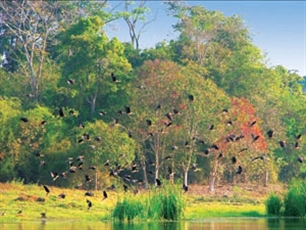
(ĐN)- Dong Nai province is home to nearly 50 national and provincial heritages. On the occasion of the international seminar entitled "The role of cultural heritages in education and peace-building" organized in the province from November 24-28. Dong Nai has a chance to introduce its heritages to Vietnamese and international friends.
(ĐN)- Dong Nai province is home to nearly 50 national and provincial heritages. On the occasion of the international seminar entitled "The role of cultural heritages in education and peace-building" organized in the province from November 24-28. Dong Nai has a chance to introduce its heritages to Vietnamese and international friends.
Here are three typical heritages in the province:
The Dong Nai Biosphere Reserve
Covering more than 966,500 ha in Dong Nai, Lam Dong, Binh Phuoc, Binh Duong and Dak Nong provinces, the Dong Nai Biosphere Reserve includes a core zone of 169,000 ha, a buffer zone of 350,000ha and a transitional zone of nearly 448,000ha.
 |
The reserve is an ideal living environment for creatures, especially mammals, birds, reptiles and fish. It is now home to over 1,400 species of plants and more than 1,700 kinds of animals, including those listed in the Red Book.
The Dong Nai Biosphere Reserve is home to 11 ethnic groups and is a model for sustainable and harmonious development between human beings and nature.
The reserve is a “live laboratory” on scientific research and new ideas on conservation and development. It will also act as a school for people to share the responsibility of environmental protection and sustainable management.
Hang Gon Megalithic Vestige
Hang Gon Megalithic Vestige in Hang Gon Hamlet in Hang Gon Commune in Long Khanh Township was found and excavated in 1927.
 |
In 1984, the Ministry of Culture ranked the Hang Gon Megalith tomb as a national vestige and considered it as one of ten key relics in the Southern area.
Scientists have identified it as a unique vestige of technical and artistic methods of ethnic people in South Asia in general and ancient Vietnam in particular.
The Bien Hoa citadel
Located in Bien Hoa city’s Quang vinh ward, the Bien Hoa citadel is a heritage site and the only Nguyen Dynasty military structure and citadel left in southern Vietnam.
 |
The 300-year-old building is historically significant for its role in the early southward thrust by the central-based Nguyen Dynasty 500 years ago and the French and American wars in the 20th century.
Originally built of earth in the 14-15th century, it was rebuilt with bricks in 1837.
The 10,816-square-meter citadel has two large buildings and two blockhouses left inside its outer walls.
Reported by V.T




![[Photo series] Admiring the most beautiful riverside road in Dong Nai before its technical traffic opening](/file/e7837c02876411cd0187645a2551379f/012026/nen_20260114174655.jpg?width=500&height=-&type=resize)